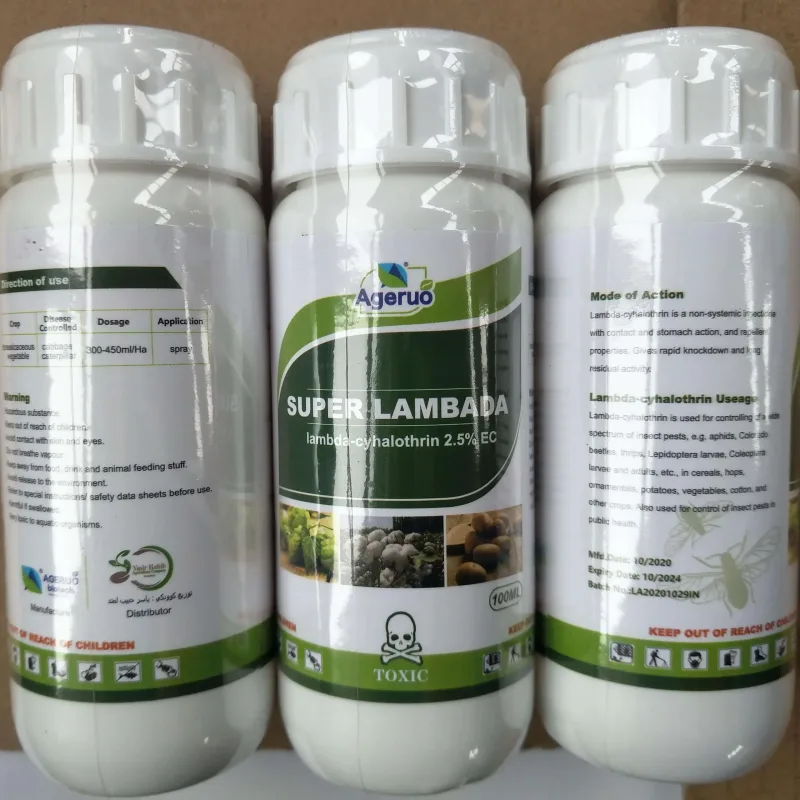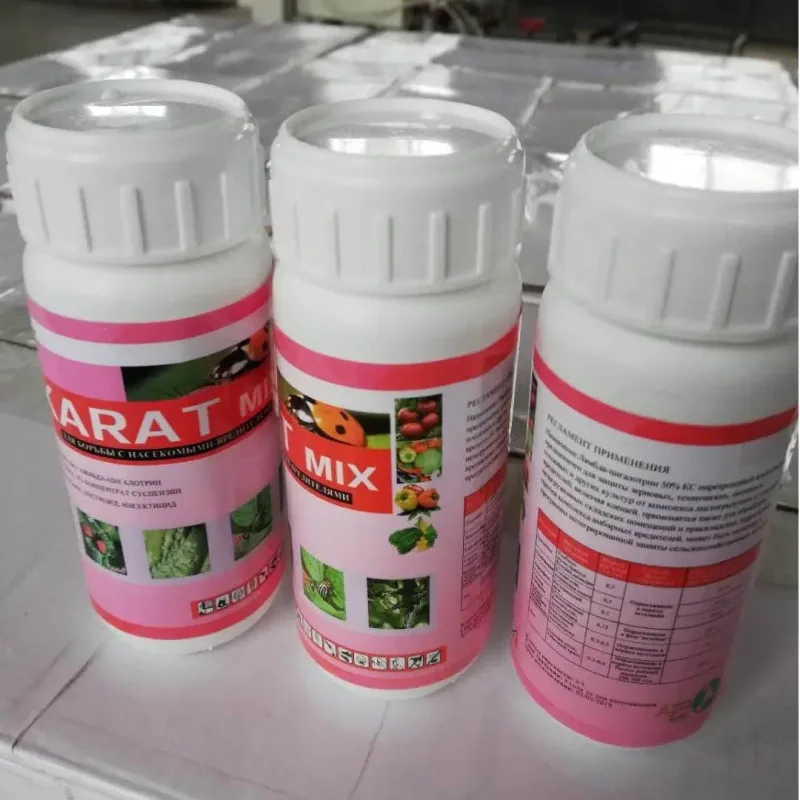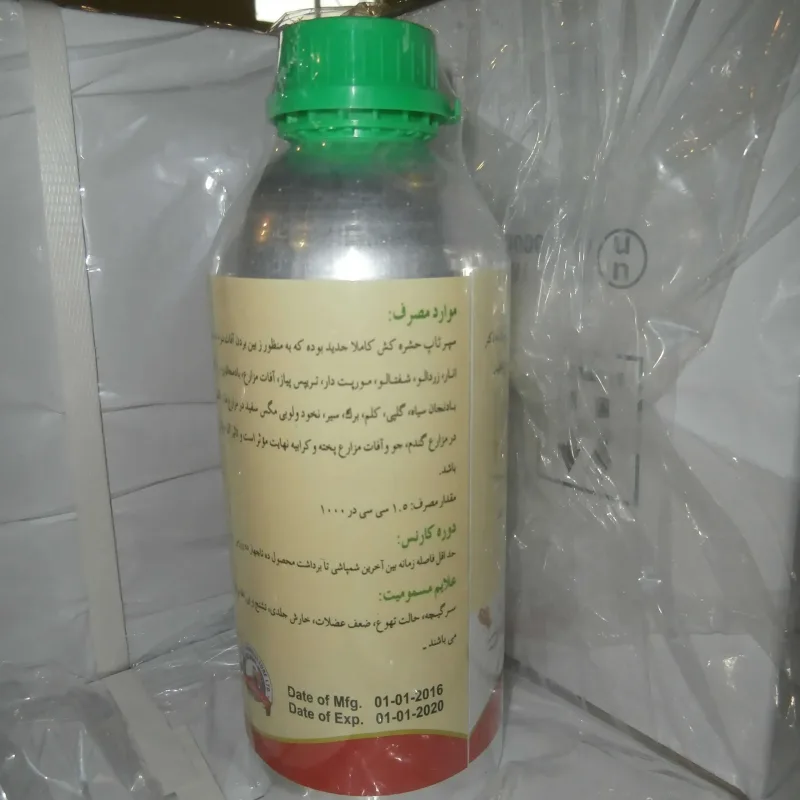Gamma-Cyhalothrin vs Lambda-Cyhalothrin
Insecticides play a crucial role in pest management, and both gamma-cyhalothrin and lambda-cyhalothrin are popular pyrethroids widely used to control various pests. While they belong to the same chemical family, their differences in structure and effectiveness make them suitable for different applications. In this article, we’ll compare these two insecticides in terms of their properties, effectiveness, uses, and more. Additionally, as a global supplier of pesticide solutions, we offer customized formulations and tailored packaging to meet the unique needs of our customers.
| Feature | Gamma-Cyhalothrin | Lambda-Cyhalothrin |
|---|---|---|
| Chemical Class | Pyrethroid | Pyrethroid |
| Mode of Action | Disrupts sodium channels, causing paralysis and death of insects | Disrupts sodium channels, causing paralysis and death of insects |
| Target Pests | A wide range, including mosquitoes, ants, fleas, ticks, and agricultural pests | A broad spectrum, including mosquitoes, cockroaches, ants, and agricultural pests |
| Formulations | EC (Emulsifiable Concentrate), SC (Suspension Concentrate) | EC (Emulsifiable Concentrate), SC (Suspension Concentrate), WP (Wettable Powder) |
| Toxicity | Moderate toxicity to humans and animals if ingested or improperly handled | Moderate toxicity to humans and animals if ingested or improperly handled |
| Duration of Action | Short to medium residual activity, dependent on conditions | Long-lasting residual effect, especially on crops |
| Common Uses | Residential pest control, mosquito control, agricultural pests | Residential and agricultural pest control, including crop protection |
| Environmental Impact | Low environmental persistence, but harmful to aquatic organisms if misused | Low environmental persistence, but requires proper disposal to avoid contamination |
Gamma-Cyhalothrin vs Lambda-Cyhalothrin
1. Chemical Composition and Structure
Both gamma-cyhalothrin and lambda-cyhalothrin belong to the pyrethroid class of insecticides, which are synthetic chemicals modeled after pyrethrins, naturally occurring insecticides found in chrysanthemum flowers. However, gamma-cyhalothrin and lambda-cyhalothrin differ in their molecular structure, which influences their activity against pests and persistence in the environment. Gamma-cyhalothrin tends to have a slightly more rapid knockdown effect, while lambda-cyhalothrin often provides longer-lasting protection.
2. Mode of Action
Both insecticides operate by affecting the sodium channels in the nervous systems of insects. This disruption leads to paralysis and death, which makes them both highly effective against a broad range of pests. The key difference between the two lies in their persistence and the spectrum of pests they target. Gamma-cyhalothrin is typically used for quick knockdown and is favored for controlling mosquitoes and flying insects, whereas lambda-cyhalothrin is often used for long-term control, especially in agricultural settings, where residual activity is desired.
3. Target Pests
- Gamma-Cyhalothrin: Effective against mosquitoes, fleas, ticks, ants, and various agricultural pests like aphids, caterpillars, and leafhoppers.
- Lambda-Cyhalothrin: Targets a broader spectrum of pests, including mosquitoes, cockroaches, ants, bed bugs, and agricultural pests such as aphids, whiteflies, and spider mites.
Both insecticides are effective in controlling household pests, public health pests, and agricultural pests, but gamma-cyhalothrin is often preferred for mosquito control and rapid knockdown applications, while lambda-cyhalothrin is more commonly used in long-term agricultural pest management.
4. Formulation Options
Both gamma-cyhalothrin and lambda-cyhalothrin are available in similar formulations, including Emulsifiable Concentrates (EC) and Suspension Concentrates (SC). Gamma-cyhalothrin is also found in formulations ideal for mosquito fogging and spraying applications, which makes it more suitable for quick, large-area coverage. On the other hand, lambda-cyhalothrin is often formulated in wettable powders (WP), which can be useful for more precise applications, such as crop protection.
5. Toxicity and Safety
Both insecticides have moderate toxicity to humans and animals if ingested or improperly handled. While neither product is classified as highly toxic, precautions should always be taken during handling and application:
- Gamma-cyhalothrin is somewhat more toxic to aquatic organisms, so it is important to avoid contamination of water sources.
- Lambda-cyhalothrin is also toxic to fish and other aquatic life, but generally safer when used according to instructions.
Always wear appropriate personal protective equipment (PPE), such as gloves and masks, when handling either insecticide.
6. Environmental Persistence
- Gamma-Cyhalothrin: Tends to break down relatively quickly in the environment but may have a more immediate impact on non-target organisms if applied improperly.
- Lambda-Cyhalothrin: Offers a longer residual effect, especially when used in agricultural fields, making it an excellent option for sustained pest control.
Both insecticides are considered to have low environmental persistence, but as with all pesticides, responsible usage and proper disposal are essential to minimize environmental harm.
Applications: When to Use Gamma-Cyhalothrin vs Lambda-Cyhalothrin
Gamma-Cyhalothrin is best for situations where a quick knockdown is required, such as mosquito control, flea and tick infestations, and general pest management in residential areas. Its rapid action makes it ideal for fogging and spraying large areas.
Lambda-Cyhalothrin, with its longer residual activity, is preferred for agricultural pest control where prolonged protection is needed, particularly in crop management for vegetables, fruits, and grains. It is also used in structural pest management, including control of termites and bed bugs.
Custom Solutions for Global Clients
As a global supplier of pesticides, we specialize in providing both gamma-cyhalothrin and lambda-cyhalothrin in various bulk quantities. We offer custom formulations that meet the specific needs of your application, whether you are managing pest control for agricultural purposes, public health, or residential settings. Additionally, we provide custom labeling, branded packaging, and product design services to ensure that your product stands out in your market.
Conclusion
Both gamma-cyhalothrin and lambda-cyhalothrin are highly effective insecticides, with key differences that make each better suited for specific applications. Gamma-cyhalothrin is preferred for quick knockdown and mosquito control, while lambda-cyhalothrin is ideal for long-term agricultural pest management and structural pest control.
As a trusted global supplier, we can help you source these powerful insecticides in bulk, with custom formulations and tailored packaging to meet your market needs. Contact us today to discuss how we can support your pest control solutions.
Insecticides play a crucial role in pest management, and both gamma-cyhalothrin and lambda-cyhalothrin are popular pyrethroids widely used to control various pests. While they belong to the same chemical family, their differences in structure and effectiveness make them suitable for different applications. In this article, we’ll compare these two insecticides in terms of their properties, effectiveness, uses, and more. Additionally, as a global supplier of pesticide solutions, we offer customized formulations and tailored packaging to meet the unique needs of our customers.
| Feature | Gamma-Cyhalothrin | Lambda-Cyhalothrin |
|---|---|---|
| Chemical Class | Pyrethroid | Pyrethroid |
| Mode of Action | Disrupts sodium channels, causing paralysis and death of insects | Disrupts sodium channels, causing paralysis and death of insects |
| Target Pests | A wide range, including mosquitoes, ants, fleas, ticks, and agricultural pests | A broad spectrum, including mosquitoes, cockroaches, ants, and agricultural pests |
| Formulations | EC (Emulsifiable Concentrate), SC (Suspension Concentrate) | EC (Emulsifiable Concentrate), SC (Suspension Concentrate), WP (Wettable Powder) |
| Toxicity | Moderate toxicity to humans and animals if ingested or improperly handled | Moderate toxicity to humans and animals if ingested or improperly handled |
| Duration of Action | Short to medium residual activity, dependent on conditions | Long-lasting residual effect, especially on crops |
| Common Uses | Residential pest control, mosquito control, agricultural pests | Residential and agricultural pest control, including crop protection |
| Environmental Impact | Low environmental persistence, but harmful to aquatic organisms if misused | Low environmental persistence, but requires proper disposal to avoid contamination |
Gamma-Cyhalothrin vs Lambda-Cyhalothrin
1. Chemical Composition and Structure
Both gamma-cyhalothrin and lambda-cyhalothrin belong to the pyrethroid class of insecticides, which are synthetic chemicals modeled after pyrethrins, naturally occurring insecticides found in chrysanthemum flowers. However, gamma-cyhalothrin and lambda-cyhalothrin differ in their molecular structure, which influences their activity against pests and persistence in the environment. Gamma-cyhalothrin tends to have a slightly more rapid knockdown effect, while lambda-cyhalothrin often provides longer-lasting protection.
2. Mode of Action
Both insecticides operate by affecting the sodium channels in the nervous systems of insects. This disruption leads to paralysis and death, which makes them both highly effective against a broad range of pests. The key difference between the two lies in their persistence and the spectrum of pests they target. Gamma-cyhalothrin is typically used for quick knockdown and is favored for controlling mosquitoes and flying insects, whereas lambda-cyhalothrin is often used for long-term control, especially in agricultural settings, where residual activity is desired.
3. Target Pests
- Gamma-Cyhalothrin: Effective against mosquitoes, fleas, ticks, ants, and various agricultural pests like aphids, caterpillars, and leafhoppers.
- Lambda-Cyhalothrin: Targets a broader spectrum of pests, including mosquitoes, cockroaches, ants, bed bugs, and agricultural pests such as aphids, whiteflies, and spider mites.
Both insecticides are effective in controlling household pests, public health pests, and agricultural pests, but gamma-cyhalothrin is often preferred for mosquito control and rapid knockdown applications, while lambda-cyhalothrin is more commonly used in long-term agricultural pest management.
4. Formulation Options
Both gamma-cyhalothrin and lambda-cyhalothrin are available in similar formulations, including Emulsifiable Concentrates (EC) and Suspension Concentrates (SC). Gamma-cyhalothrin is also found in formulations ideal for mosquito fogging and spraying applications, which makes it more suitable for quick, large-area coverage. On the other hand, lambda-cyhalothrin is often formulated in wettable powders (WP), which can be useful for more precise applications, such as crop protection.
5. Toxicity and Safety
Both insecticides have moderate toxicity to humans and animals if ingested or improperly handled. While neither product is classified as highly toxic, precautions should always be taken during handling and application:
- Gamma-cyhalothrin is somewhat more toxic to aquatic organisms, so it is important to avoid contamination of water sources.
- Lambda-cyhalothrin is also toxic to fish and other aquatic life, but generally safer when used according to instructions.
Always wear appropriate personal protective equipment (PPE), such as gloves and masks, when handling either insecticide.
6. Environmental Persistence
- Gamma-Cyhalothrin: Tends to break down relatively quickly in the environment but may have a more immediate impact on non-target organisms if applied improperly.
- Lambda-Cyhalothrin: Offers a longer residual effect, especially when used in agricultural fields, making it an excellent option for sustained pest control.
Both insecticides are considered to have low environmental persistence, but as with all pesticides, responsible usage and proper disposal are essential to minimize environmental harm.
Applications: When to Use Gamma-Cyhalothrin vs Lambda-Cyhalothrin
Gamma-Cyhalothrin is best for situations where a quick knockdown is required, such as mosquito control, flea and tick infestations, and general pest management in residential areas. Its rapid action makes it ideal for fogging and spraying large areas.
Lambda-Cyhalothrin, with its longer residual activity, is preferred for agricultural pest control where prolonged protection is needed, particularly in crop management for vegetables, fruits, and grains. It is also used in structural pest management, including control of termites and bed bugs.
Custom Solutions for Global Clients
As a global supplier of pesticides, we specialize in providing both gamma-cyhalothrin and lambda-cyhalothrin in various bulk quantities. We offer custom formulations that meet the specific needs of your application, whether you are managing pest control for agricultural purposes, public health, or residential settings. Additionally, we provide custom labeling, branded packaging, and product design services to ensure that your product stands out in your market.
Conclusion
Both gamma-cyhalothrin and lambda-cyhalothrin are highly effective insecticides, with key differences that make each better suited for specific applications. Gamma-cyhalothrin is preferred for quick knockdown and mosquito control, while lambda-cyhalothrin is ideal for long-term agricultural pest management and structural pest control.
As a trusted global supplier, we can help you source these powerful insecticides in bulk, with custom formulations and tailored packaging to meet your market needs. Contact us today to discuss how we can support your pest control solutions.







